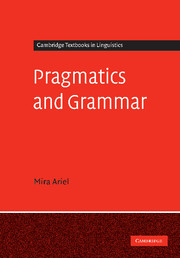Book contents
- Frontmatter
- Contents
- List of tables
- Preface
- Acknowledgments
- How to use this book
- Transcription conventions
- 1 Introduction: Grammar, pragmatics, and what's between them
- PART I Drawing the grammar/pragmatics divide
- PART II Crossing the extralinguistic/linguistic divide
- Part III Bringing grammar and pragmatics back together
- References
- Author index
- Subject index
1 - Introduction: Grammar, pragmatics, and what's between them
Published online by Cambridge University Press: 05 September 2012
- Frontmatter
- Contents
- List of tables
- Preface
- Acknowledgments
- How to use this book
- Transcription conventions
- 1 Introduction: Grammar, pragmatics, and what's between them
- PART I Drawing the grammar/pragmatics divide
- PART II Crossing the extralinguistic/linguistic divide
- Part III Bringing grammar and pragmatics back together
- References
- Author index
- Subject index
Summary
Pragmatics has been notoriously hard to define. Or rather, it has proven quite impossible to reconcile between the patterning of phenomena assumed to be classical pragmatic topics (deixis and reference, speech acts, conversational and conventional implicatures, presuppositions, functional syntax) and the common set of definitions for pragmatics (most notably, context dependency, inferentiality, nontruth conditionality and others). In order to resolve the delimitation problem of the field we are forced to first abandon the expectation that all the definitional criteria converge on classifying some phenomenon as pragmatic (or as grammatical). In other words, we cannot expect that any given pragmatic phenomenon will simultaneously meet all the criterial definitions for pragmatics (and vice versa for grammatical phenomena). For example, while deixis is pragmatic in that it is context-dependent, it cannot meet the nontruth-conditionality criterion (for it contributes a truth-conditional meaning).
In addition, we must give up on what I have elsewhere called the topical approach to pragmatics, which assumes that all aspects of some phenomenon (e.g. of deixis, of presupposition, etc.) uniformly belong in pragmatics, or else, that all of them uniformly belong in grammar (see Ariel, forthcoming and chapter 2). Any specific instance of language use is neither wholly grammatical nor wholly pragmatic. To pick deixis again, it combines grammatical aspects (there is a grammatically specified difference between I and this) with pragmatic aspects (pinning down who the speaker is, what object this denotes).
- Type
- Chapter
- Information
- Pragmatics and Grammar , pp. 1 - 24Publisher: Cambridge University PressPrint publication year: 2008



